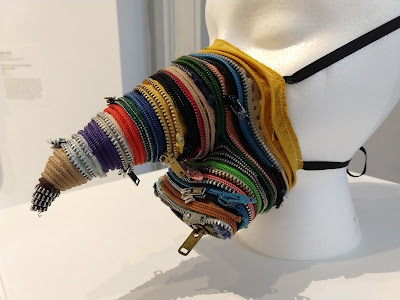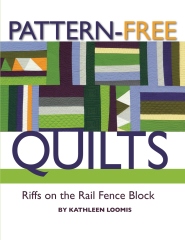Ingrid Lincoln left a comment on my last blog post: "I know these are photos so I may not be seeing everything, but it appears these quilts do not have the usual bindings. Are bindings out for art quilts?"
Good eye, Ingrid! You're right that none of the quilts I've shown so far have bindings. And after I read the comment, I looked through all my photos and discovered that not a single quilt in FNF has a traditional binding. Last year, only three out of 17 had bindings. Not sure I'd say they're "out," but I think it's safe to say that bindings are not the standard finish for art quilts these days.
Lee Sproull, Archilinea, detailWhy is that? I've delivered many rants on this subject, so I have thought it through. In my opinion, contemporary quilters who want their work to be seen as art feel a need to distance themselves from traditional quilts. Although we love the format and the feel of quilts, we don't want people to immediately see our work as something their grandmother would have made and put on the bed. One way to sever ties with tradition is to omit the binding.
In addition, omitting the binding mirrors a trend in contemporary painting in which traditional frames are no longer necessary. Painters often feel that frames, especially the elaborate models that surround so many older works, are too constraining. They hold the picture in, instead of letting it breathe freely and occupy its own space confidently. Go to a gallery or contemporary museum and many, if not most of the paintings will be unframed.
Bobbe Nolan, Flyover 10 -- Dancing in the Rainbow Mountains, detailIf you don't finish a quilt with a traditional binding, you can either leave the edges raw or overcast (don't shudder -- sometimes that looks just fine) or use a facing, a strip of fabric applied much like a binding but turned entirely to the back so it's invisible. Facings are especially useful for quilts with jagged, irregular edges. (Here's my tutorial on how to make perfect facings without lumpy corners, and how to face a curved edge.)
I'm a bit conflicted about bindings. I usually go with facings because of wanting to look less like quilts, more like art. But bindings are easier to do, way less fiddly, even with mitered corners. They lie flatter because there's less bulk. In a few situations you want that crisp narrow contrast edge for artistic value. And in others, you can make the binding into a non-event by matching the color of the adjacent piecing. (Here's my tutorial on how to make perfect bindings: part 1, cutting; part 2, sewing; part 3, folding and stitching.)
I advise my students to learn both methods of finishing, and choose the one that seems to work best for the situation.





















